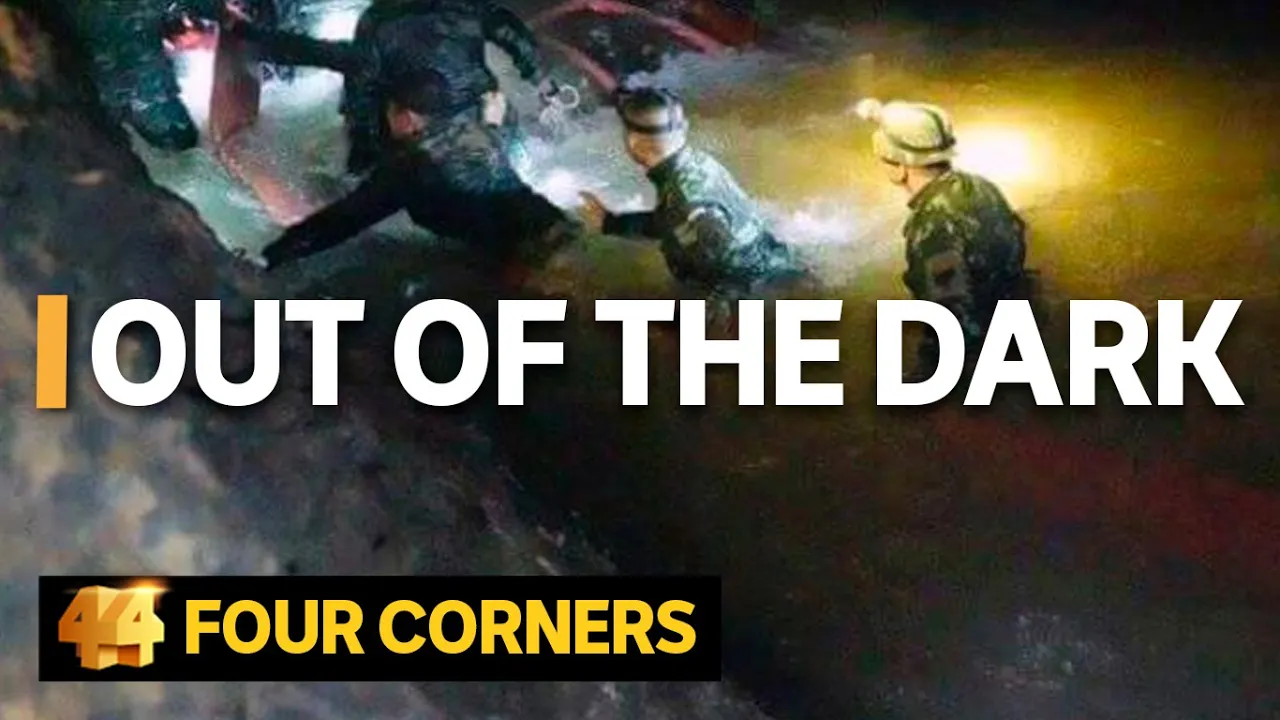Advanced training and equipment are necessary for cave diving, but it is often the experience acquired by actually diving in caves that proves to be even more important than equipment or training. Attention to detail in planning cave dives is essential, and failure to address even the most minute issues can have grave consequences. Candidates selected for cave-diving training programs must have a record of disciplined diving and demonstrate commitment to completing the rigorous program.
The Intro to Cave Diver course from Technical Diving International (TDI), for example, lasts a minimum of four days. Completion of this prerequisite course allows candidates age 18 and older to enroll in a TDI Full Cave Diver course.
With this information in mind, suppose you were a cave-diving instructor asked to teach more than a dozen children, ranging in age from 11 to 17 years old, to navigate a long, narrow cave passage with low visibility. Your classroom has no light, your prospective students have never been swimming, let alone diving, and they may not speak your language. You are sleep deprived throughout the course, and the students are starving, dehydrated and frightened for their lives because they’ve been trapped in a dark and steadily flooding cave for days.
Could you take on this challenge? Many would not, but fortunately for those children some of the world’s most dedicated cave divers rose to the occasion.
This grim situation was a reality this summer when a soccer team of young boys and their coach became trapped in Thailand’s Tham Luang Nang Non cave system after unanticipated monsoon rains flooded their only way out. Ben Reymenants was one of the elite cave divers who worked tirelessly to help rescue the team. We thank him for taking the time to answer some questions about the experience.
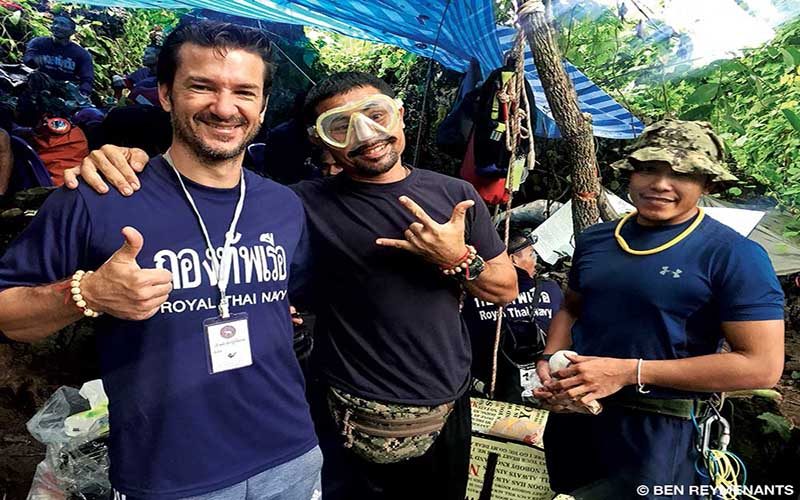
What were your first thoughts after you got the call, and what did you do?
I had heard that the soccer team becoming trapped in the cave and that the military was setting up an evacuation plan. I thought about volunteering, but I didn’t know how to contact any of the commanders. The next day I read that the British cave rescue team had arrived, so I figured there was enough expertise at site. The following day, however, I received a call from a liaison officer to the Thai Navy, who told me that the British divers didn’t have the manpower and equipment to complete the task. I had no information about the cave and knew only that time was running out since heavy monsoon rains were expected. I packed two cylinders and a small rebreather and hopped on a plane.
You’re an accomplished cave diver who lives in Thailand, so you’re familiar with Thai caves. Tell us about this one.
Tham Luang is very different from the caves we usually dive. The topography isn’t particularly unusual, but the cave is long (6.2 miles), the flow is unpredictable, and the visibility is very bad. This cave had never been dived before, as it is considered too dangerous, so we had to explore and lay roughly 2 miles of thick rope. I have no desire to dive this cave again, though some of us will probably return in December when the water recedes to try to recover some of the dive gear we had to leave behind when the cave flooded on the last day (one of the main pumps broke two hours after the last stretcher got out).
What were the options for rescuing the team?
Among the solutions proposed (and in some cases attempted) were inflating a long tube the kids would crawl through, drilling a hole from the surface, teaching the kids to dive, installing giant pumps to drain the water from the cave, or leaving the kids in the cave for the three- to four-month monsoon season with two doctors and adequate food and medical supplies.
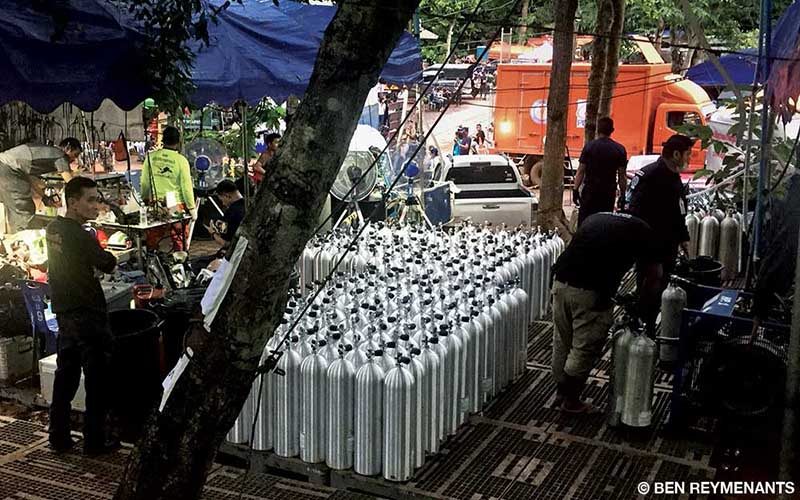
The team was very far from the entrance; getting to them involved cave diving, navigating dry stretches with cave-diving gear and then more cave diving. What were the most significant logistical challenges?
The only map we had was 30 years old and had been drawn by hand by French dry cavers. In the early days of the operation the flow was so strong it took me three hours to get to Chamber 3 (about a mile inside the cave). The conditions were a mix of strong flow, muddy passages with zero visibility and muddy rock piles that we had to climb over with our cylinders and rebreathers. The air in these dry chambers had a low oxygen and high carbon dioxide content, which made the dry caving similar to high-altitude climbing. Once past Chamber 3, the real diving work started; it went very slowly in the first days because of limited (1 foot) visibility and high flow.

Finding your way through an unknown cave by feel while dragging a large bag with more than 200 yards of climbing rope was quite taxing, both physically and mentally. I became entangled in loose line a few times and stuck in small restrictions about half a dozen times. Once the line was laid, about 400 cylinders had to be staged along the line in preparation for the extraction. The Thai Navy SEALs did the majority of the cylinder runs, which was extremely hard as it involved dragging and pushing multiple cylinders through the restrictions.
What were the most significant concerns in the early stages of the operation, and how were these addressed?
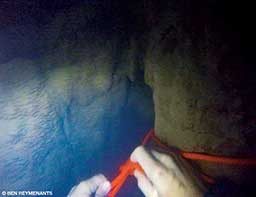
Getting stuck in restrictions. Some of these restrictions were small outflowing passages, which created suction and thus were very dangerous.
Distance. The total distance to the kids was about 2 miles against flow, and the water was 65°F and muddy. Most dives took about six hours, and the mental and physical fatigue combined with doubt made it very hard to keep pushing further, not knowing if the kids would be alive or actually where they were believed to be.
Equipment failure. The constant impact against the rocks, mud entering regulators or loss of gas, light or line could have been fatal. My main light broke, my drysuit ripped and flooded, my dive computer broke, and I lost a fin in the ripping current on my way out. Cave divers always carry at least two of any crucial pieces of equipment: two masks, three torches, two cylinders and a rebreather and, of course, two fins. I also had a couple of energy bars and a drinking bag with three liters of isotonic fluids.
Once the team was found alive, it is easy to imagine the scale of the response escalating rapidly, with the arrival of additional resources: people, food, water pumps, equipment and more. How was such a huge, complex operation managed? Did the situation change daily? Were there regular briefings?
It was organized chaos, to say the least; there was an overflow of resources at first and too many cooks in the kitchen. The commander of the Thai Navy SEALs took charge, however, and decided who and what equipment went into the cave. Every day there was a briefing in Thai and in English. The teams inside the cave became more numerous as time went on and as more international military personnel arrived from different countries. Each of them had a specialty, however, and in the end it all worked like a well-oiled machine.
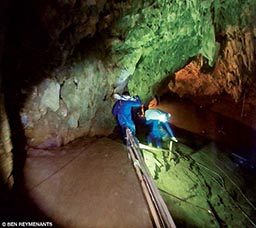
It appeared that the army of supporters was well managed and did not interfere with the rescue operations. What kind of support did you get?
Police and military personnel kept media and supporters at a safe distance. A medical tent was set up with free medical care (we got lots of cuts and abrasions on our hands) along with large tents that provided free food around the clock. The support by the Thai volunteers at the entrance to the cave was amazing; I felt like I was treated like a king.
How did you manage to train the boys to use breathing equipment and then prepare them for the stressful and dangerous dive?
The large pumps worked well; by the time the actual extraction process started, the cave was about two-thirds drained of water. After assessing the condition of the kids, it was decided that each one would be carried out on a foldable stretcher after being sedated and given a full-face mask with positive pressure oxygen being fed from a cylinder carried by the rescue divers.
How did rescue divers manage the children they carried through the flooded cave?
Because the children were sedated, they were unresponsive. Each rescuer had a bottle and syringes to keep the kids sedated throughout the two- to three-hour trip. Each rescuer carried an oxygen cylinder with a quick connector to plug into the full-face mask. About every 100 yards, a new rescue buddy team would take over carrying the stretcher. Roughly 30 divers were needed to get the stretchers to Chamber 3.
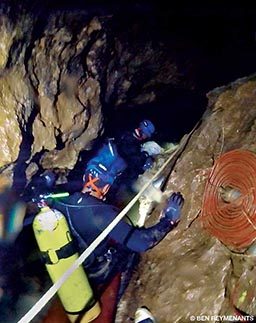
What other teams were involved?
A team from China arrived and designed a zipline to more quickly transport the cylinders from the surface to Chamber 3. A local rock-climbing school helped install the system by drilling hooks in the ceiling. The U.S. military set up two field hospitals: in Chamber 3 and near the exit. British and local expatriate cave divers helped carry out the stretchers. Craig Challen and Richard Harris, M.D., two well-known Australian cave divers, dictated the actual extraction process with the full-face masks and foldable stretchers.
Even among highly experienced cave divers, this rescue was considered nothing short of miraculous. When times felt desperate, were you ever worried that not everyone would make it out alive?
A team of doctors in the hyperbaric center in Malta was advising me daily. They informed me that if the kids had found a dry space and were not injured, they had a pretty good chance of being alive, because fresh water was dripping from the stalactites and the temperature inside the dry areas was 79°F. Still, there were a lot of unknowns with regard to the kids having found higher ground and being at the spot where they were thought to be. Once they were found, the clock started ticking — heavy monsoon rains were expected and could flood the cave again.
Tragically, retired Thai Navy SEAL diver Saman Gunan drowned during the rescue, which highlighted the very real danger of the operation. What happened in his case?
This is still unclear. One reason might be fouled air. Roughly 40 cylinders had to be drained because exhaust fumes from the multiple compressors and generators had made it into the air intake. This problem was resolved, but a few contaminated tanks might have made it into the cave. The second reason might be confusion. Saman had access to multiple cylinders, but in the bad visibility he might not have found the spare regulator when his main cylinder ran out of gas.
How did you monitor and address deteriorating environmental conditions within the cave?
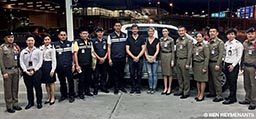
I could not. Generally I could read my instruments only when I surfaced in small air pockets every 20 minutes or so. The maximum depth was 20 feet, so I knew I could pump pure oxygen into my rebreather without the need to monitor oxygen or depth.
What was the impact of the pumps and stream diversions on the water levels in the caves?
The initial pumps did very little, but the flow lessened after a dam was built on a small river that fed into the cave. A hole was drilled upstream as well, which drained a lot of water. Two large pumps supplied by a Dutch company did the majority of the work. Three billion liters were drained from the cave, flooding vast areas of farmland nearby.
Rescue divers from this mission have received medals and have been recognized in worldwide media. How are you handling the public and media attention?
Thai Prime Minister Prayuth Chan-ocha recently awarded a medal to me and some of my fellow expat cave divers. The media attention is slowly calming down, but it was indeed unexpected, especially since I had not watched any TV around the time of the operation. I had seen the wall of cameras lining the entrance of the cave, but I did not anticipate the media storm that would follow. I guess the world loves a good rescue story. It was good to be a part of this successful and giant operation involving 10,000 people working toward a common goal.
Explore More
| © Alert Diver — Q4 2018 |
